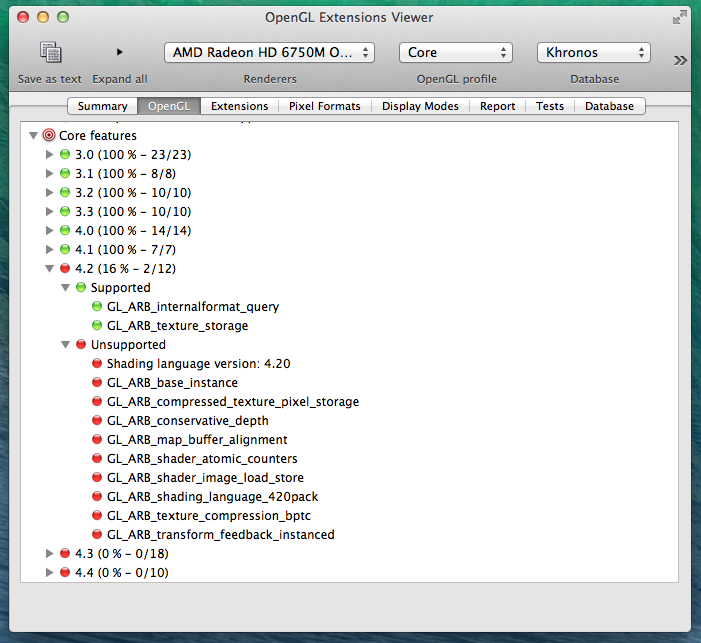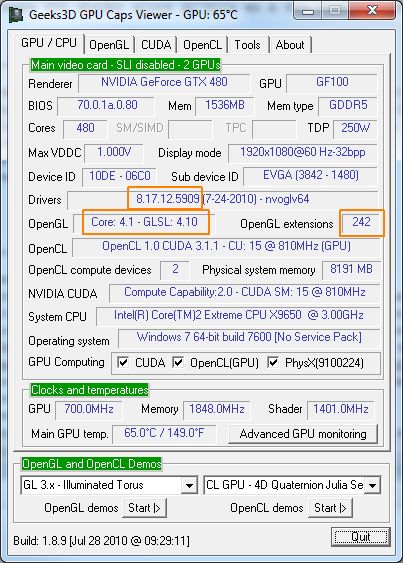OpenGL for Macintosh enables your computer to display three-dimensional graphics using applications designed to take advantage of OpenGL. Mac Games are more real, more powerful and more fun. Oct 13, 2019.
New version 6.0 for Windows, now available, 20th Anniversary of OpenGL Extensions Viewer!
A reliable software which displays useful information about the current OpenGL 3D accelerator and new Vulkan 3D API. This program displays the vendor name, the version implemented, the renderer name and the extensions of the current OpenGL 3D accelerator.
What's new ?
Opengl 3.0 Download Windows 10
6.1.2 - Latest Version (2020-06-23)
- Android Vulkan Database
- Support for virtual renderer (without monitors)
- Vulkan extensions database browser.
- Entirely rewritten interface in WPF, optimized for Windows 10, search functions, new high definitions icons, new vendors icons and more.
- Vulkan extensions database browser
- New generated database, up to 10,000 renderers, with version and more
- Faster loading times,
- New CPUID section with processor name and number.
- Many bug fixes and improvements.
5.3.4
- Updated video memory size using AMD and nVidia GL Extensions. This now reports more than 4GB size. Adding GPU processor clock for AMD video cards.
- nVidia and AMD drivers version are now reported properly.
- Fixed an issue with WMI 'AdapterRAM' crashing at startup.
- Improved database navigation.
5.2.0 (2019-03)
- Updated processor detection : Added more processor family.
- Version is displayed when starting the application.
- Improved database navigation.
5.1.4 (2019-01)
Opengl Driver Download
- Improved Vulkan Support
- Support for high density screens
- Improved database
OpenGL Extension Viewer is reliable software which displays the vendor name, the version implemented, the renderer name, and the extensions of the current OpenGL 3D accelerator. Many OpenGL extensions, as well as extensions to related APIs like GLU, GLX, and WGL, have been defined by vendors and groups of vendors. The extension registry is maintained by SGI and contains specifications for all known extensions, written as modifications to the appropriate specification documents. The registry also defines naming conventions, guidelines for creating new extensions and writing suitable extension specifications, and other related documentation.

OpenGL Extensions Viewer is free of charge and was awarded by Softpedia as 100% FREE No Spyware, No Adware, No Viruses
You can download the latest version of OpenGL Extensions Viewer. from those selected App Store
Or, if you run Windows 7 or later, click here to download for Windows:
Download For Windows (*)
Also available, DirectX Extensions Viewer on Windows Store:
(*) This program might requires .NET Framework. IMPORTANT: This application is NOT digitally signed, and your browser may block the download or your virus scanner may recommend to NOT download this program
USER MANUALAfter launching the application, select one of the following tab: OpenGL Extensions Display Modes Pixel Formats Report OpenGL 1.1 : use the standard OpenGL without extension usage. Links |
OpenGL EXTENSIONSA very extensive list of details of all extensions available of your system, which OpenGL functions are implemented and more. OpenGL Extensions Viewer has been suggested by OpenGL.org Vulkan Extensions are available in the Vulkan Report Section |
RENDERER DATABASEA database of all known renderers for Windows and MacOSX is available. If an renderer is being updated, you can submit to the server. You can also update to the latest database directly from the application. |
FAQComing soon ! |
Initial released in 2000
Available for iOS, Android, Windows 7 and above, macOS
Example
1. Install GLFW
First step is to create an OpenGL window. GLFW is an Open Source, multi-platform library for creating windows with OpenGL, to install GLFW first download its files from www.glfw.org
Extract the GLFW folder and its contents will look like this
Download and install CMake to build GLFW. Goto www.cmake.org/download/, download CMake and install for MAC OS X

If Xcode is not installed. Download and install Xcode from Mac App Store.
Create a new folder Build inside the GLFW folder
Open CMake, click on Browse Source button to select the GLFW folder (make sure that CMakeLists.txt) is located inside that folder. After that, click on Browse Build button and select the newly created Build folder in previous step.
Opengl 2.1 Download Windows 10
Now Click on Configure button and select Xcode as generator with Use default native compilers option, and click Done.
Tick on BUILD_SHARED_LIBS option and then click on Configure button again and finally click Generate button.
After generation CMake should look like this
Now Open Finder and goto /usr, create a folder name local if not already there. Open the local folder and create two folders include and lib if not already there.
Now open the GLFW folder and goto Build (where CMake had built the files). Open GLFW.xcodeproj file in Xcode.

Select install > My Mac and then click on run (Play shaped button).
It is now successfully installed (ignore the warnings).
To make sure Open Finder and goto /usr/local/lib folder and three GLFW library files will be already present there (If not then open Build folder inside GLFW folder and go to src/Debug copy all files to /usr/local/lib)
Open Finder and goto /usr/local/include and a GLFW folder will be already present there with two header files inside it by name of glfw3.h and glfw3native.h
2. Install GLEW
GLEW is a cross-platform library that helps in querying and loading OpenGL extensions. It provides run-time mechanisms for determining which OpenGL extensions are supported on the target platform. It is only for modern OpenGL (OpenGL version 3.2 and greater which requires functions to be determined at runtime). To install first download its files from glew.sourceforge.net
Extract the GLFW folder and its contents will look like this.
Now open Terminal, navigate to GLEW Folder and type the following commands
Now GLEW is successfully installed. To make sure its installed, Open Finder, go to /usr/local/include and a GL folder will be already present there with three header files inside it by name of glew.h, glxew.h and wglew.h
Open Finder and go to /usr/local/lib and GLEW library files will be already present there
3. Test and Run
Now we have successfully installed GLFW and GLEW. Its time to code. Open Xcode and create a new Xcode project. Select Command Line Tool then proceed next and select C++ as language.
Xcode will create a new command line project.
Click on project name, and under Build Settings tab switch from Basic to All, under Search Paths section, add /usr/local/include in Header Search Paths and add /usr/local/lib in Library Search Paths
Click on project name, and under Build Phases tab and under Link With Binary Libraries add OpenGL.framework and also add recently created GLFW and GLEW libraries from /usr/local/lib
Now we are ready to code in Modern Open GL 4.1 on macOS using C++ and Xcode. The following code will create an OpenGL Window using GLFW with Blank Screen Output.